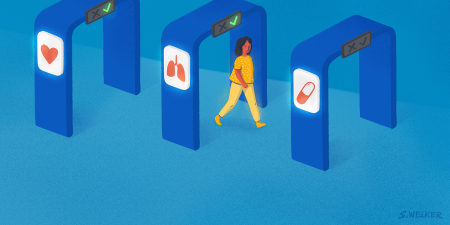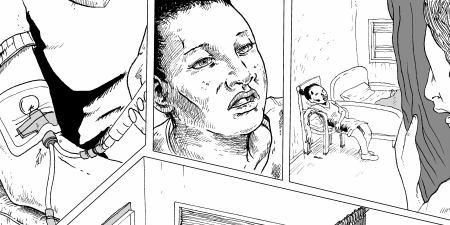Abstract
Art world superstar Jean-Michel Basquiat painted the electrically vibrant, sketchy skull, Untitled, before dying of a heroin overdose at age 27. The painting’s imagery and its creator’s substance use struggles call to mind the victims of the current opioid epidemic. Large donations from the Sackler family, patrons of numerous museums and arts institutions, have prompted questions about art world affiliation and accountability. Largely in response to protests staged by activists such as artist Nan Goldin, numerous museums have renounced Sackler funding. What more can arts organizations consider doing amidst the crisis? The Currier Museum of Art in New Hampshire offers community support and suggests a framework for museums’ roles in healing.
Memento Mori
Jean-Michel Basquiat’s Untitled (1982) depicts an electrically vibrant, sketchy, and disfigured skull with a gaping mouth, bared teeth, and eyes bulging amid layers of frenetic marks against a toxic blue background. Now in the collection of Yusaku Maezawa, the large work in acrylic, spray paint, and oil stick on canvas measures 721/8 x 681/8 inches.1 The skull’s face, demonstrative of rage or despair, is both visually abrasive and perversely stimulating in its display of color and emotion. Arguably, the work serves as a memento mori—a painted reminder of mortality and the transience of human life. In the history of Western painting, memento mori appear in the forms of expiring hourglasses, overripe fruit, or extinguished candles. The skull is the most frequently used symbol in this genre.2
Almost serving as a memento mori himself, Basquiat died of a heroin overdose in 1988 at the age of 27.3 When viewed today through the lens of addiction, the artist’s work Untitled takes on new meaning. Against a backdrop of declining life expectancy and growing numbers of deaths by opioid overdose, Untitled resonates powerfully and poignantly with contemporary social realities of the opioid crisis.
Protesting Opioid-Based Arts Funding
Sackler family companies continue to profit from selling opioids, such as oxycodone, and opioid addiction treatments, such as naloxone.4 International arts patronage from the Sackler family has prompted questions about financial accountability within arts institutions throughout the United States and abroad. Artist Nan Goldin is a recovered opioid use disorder patient who founded the Prescription Addiction Intervention Now Sackler organization (PAIN Sackler) to raise awareness about Sackler influence on the arts and to demand that public institutions both remove Sackler insignia from their premises and refuse future Sackler funding.5 PAIN Sackler and other advocacy groups call upon the Sackler family to devote their $13 billion fortune (as of 2016)6 to rehabilitating patients.
Patronage from some has prompted questions about financial accountability within arts institutions throughout the US and abroad.
In March 2018, demonstrators led by PAIN Sackler members gathered near the famed Egyptian Temple of Dendur in the Sackler Wing at the Metropolitan Museum of Art in New York City, throwing prescription pill bottles into the reflecting pool and unfurling banners that read “Fund rehab.”7 In February 2019, PAIN Sackler activists protested at the Solomon R. Guggenheim Museum in New York City, staging a performed “die-in” with fake prescription slips raining through the rotunda.8 In response to these efforts and increased media attention, the National Portrait Gallery in London, the Tate Modern in London, and the Metropolitan and Guggenheim in New York City all publicly renounced Sackler funding in 2019.9
Goldin is not alone in utilizing her creative practice and platform as a means of protest. Sculptor Domenic Esposito has repeatedly and surreptitiously placed a 10-ft, 800-lb metal sculpture of a bent heroin spoon outside Sackler companies headquartered in Connecticut and Rhode Island, the Massachusetts State House, and the Department of Health and Human Services in Washington, DC.10 For the last 12 years, artist Jeffrey Stockbridge photographed those whom he calls “abandoned people” of the opioid crisis in Philadelphia. Exploring the city’s poorest neighborhoods, Stockbridge’s documentary-style photography highlights the humanity and vulnerability of his subjects.11
The Art of Hope
Arts institutions are joining artists and those affected by the crisis in this public engagement. In Manchester, New Hampshire, the state with the highest number of fentanyl deaths per capita in the United States in 2018,12 the Currier Museum of Art has founded The Art of Hope program as a resource for those affected by substance use disorders. Museum educators use artworks in the institution’s collection for art projects and discussions about self-care, shame, and strategies for resilience and recovery. Lynn Thomson, the museum’s manager of family and community engagement, explained how the program began with a focus on responding to the question: What is Manchester dealing with now, and what does the community need?12 In the Currier program, participants are invited to reflect on paintings that depict, for example, a shipwreck in a storm, which can help catalyze conversations about addiction and the role of social support in recovery.
What else can arts organizations be doing to support families and communities affected by addiction? Expanding the Currier program to other institutions and incorporating addiction treatment information, art therapy, and other sources of support into public programming could be a start. Artworks like Basquiat’s Untitled can help catalyze conversations about the pain, loss, and healing of those affected by substance use disorders. Perhaps the memento mori, in addition to reminding viewers of life’s fragility, can also galvanize health care and arts organizations’ clinical and policy-level initiatives to save lives.
References
-
Dwyer C. At $110.5 million, Basquiat painting becomes priciest work ever sold by a US artist. NPR. May 19, 2017. https://www.npr.org/sections/thetwo-way/2017/05/19/529096175/at-110-5-million-basquiat-painting-becomes-priciest-work-ever-sold-by-a-u-s-arti. Accessed April 22, 2020.
-
Tate. Art term: memento mori. https://www.tate.org.uk/art/art-terms/m/mementomori. Accessed April 22, 2020.
-
Wainwright L. Jean-Michel Basquiat. Encyclopedia Britannica. https://www.britannica.com/biography/Jean-Michel-Basquiat. Accessed May 7, 2020.
-
Hakim D, Rabin RC, Rashbaum WK. Lawsuits lay bare Sackler family’s role in opioid crisis. New York Times. April 1, 2019. https://www.nytimes.com/2019/04/01/health/sacklers-oxycontin-lawsuits.html. Accessed April 22, 2020.
-
Bishara H. PAIN Sackler storms Guggenheim and Metropolitan museums for financial ties to opioid manufacturers. Hyperallergic. February 10, 2019. https://hyperallergic.com/484109/pain-sackler-storms-guggenheim-and-metropolitan-museums-for-financial-ties-to-opioid-manufacturers/. Accessed April 22, 2020.
-
Warren K, Rogers TN. The family behind OxyContin pocketed $10.7 billion from Purdue Pharma. Meet the Sacklers, who built their $13 billion fortune off the controversial opioid. Business Insider. March 23, 2020. https://www.businessinsider.com/who-are-the-sacklers-wealth-philanthropy-oxycontin-photos-2019-1. Accessed May 8, 2020.
-
Walters J. Artist Nan Goldin stages opioids protest in Metropolitan Museum Sackler Wing. Guardian. March 11, 2018. https://www.theguardian.com/us-news/2018/mar/10/opioids-nan-goldin-protest-metropolitan-museum-sackler-wing. Accessed April 22, 2019.
-
Gessen M. Nan Goldin leads a protest at the Guggenheim against the Sackler Family. New Yorker. February 10, 2019. https://www.newyorker.com/news/our-columnists/nan-goldin-leads-a-protest-at-the-guggenheim-against-the-sackler-family. Accessed April 22, 2020.
-
Harris E. The MET will turn down Sackler money amid fury over the opioid crisis. New York Times. May 15, 2019. https://www.nytimes.com/2019/05/15/arts/design/met-museum-sackler-opioids.html. Accessed April 22, 2020.
-
Moynihan C. Large-scale art protest outside OxyContin maker ends in arrest. New York Times. June 22, 2018. https://www.nytimes.com/2018/06/22/arts/design/art-protest-arrest-at-oxycontin-maker.html. Accessed April 22, 2020.
-
Small Z. Documenting the horrors of America’s opioid crisis in one of the hardest-hit cities. Hyperallergic. March 15, 2019. https://hyperallergic.com/489769/documenting-the-horrors-of-americas-opioid-crisis-in-one-of-the-hardest-hit-cities/. Accessed April 22, 2020.
-
Solly M. How a New Hampshire museum is using art to reach families affected by the opioid crisis. Smithsonian Magazine. December 10, 2018. https://www.smithsonianmag.com/smart-news/new-hampshire-museum-uses-art-reach-families-affected-opioid-crisis-180970978/ Accessed April 22, 2020.



